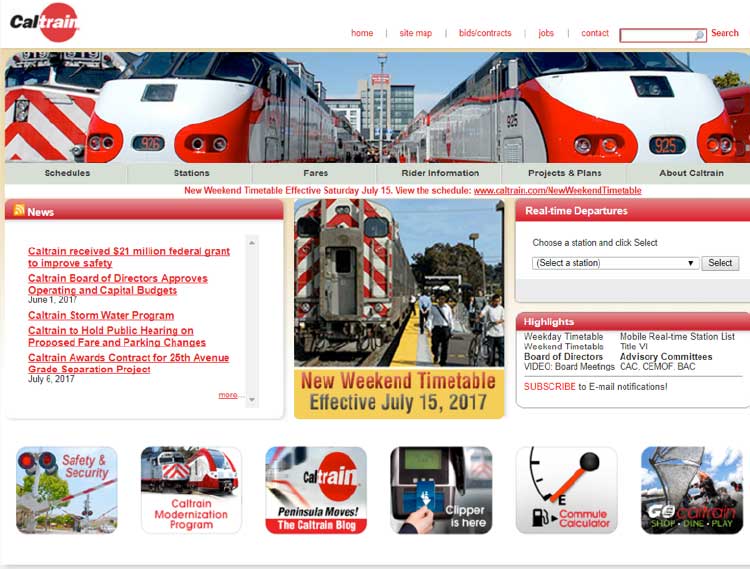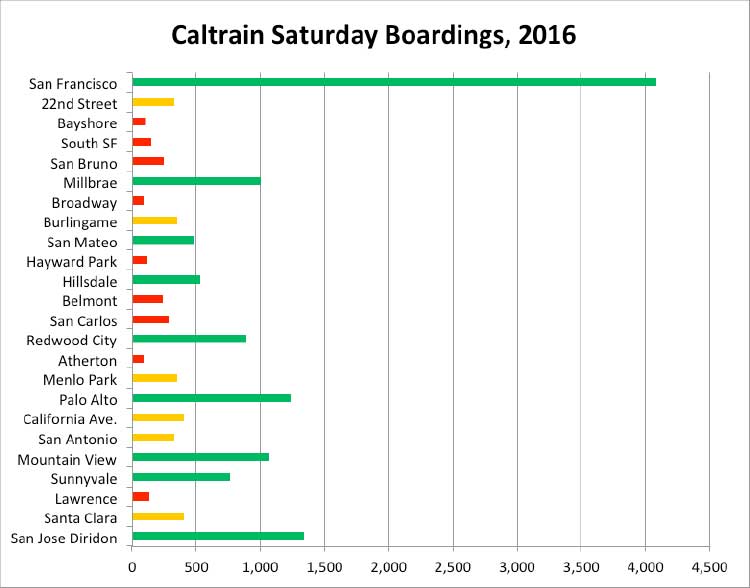After surviving a last-minute attack by California Republicans, Caltrain’s much-needed electrification project is finally commencing construction. With a 2021 opening date, the project will bring faster, more frequent “BART-like” service to the Peninsula and add much-needed capacity to a corridor that’s seen ridership nearly double since 2010.
However, the four year construction period brings significant cuts to weekend service. Beginning last Saturday, Caltrain eliminated eight weekend trains to enable single tracking of trains during construction, reducing service headways from 60 to 90 minutes. Coupled with an increase in end-to-end travel time to one hour and 44 minutes, trips between San Jose and San Francisco can now take in excess of three hours. In its March board meeting, it’s not clear that Caltrain considered any alternative approaches to serving its 15,000 Saturday passengers and 12,000 Sunday passengers during construction.
There’s no sugarcoating how brutal these cuts will be for weekend passengers traveling to work, a Giants’ game, or other events and activities. Some passengers accustomed to current schedules may be caught off guard: Caltrain’s website announces the cuts simply as a “new weekend timetable,” as opposed to something more fitting like “weekend construction alert: expect 30 minute delays.” When weighing 50 percent longer wait times against driving, calling an Uber or Lyft, or taking a SamTrans or VTA bus, many passengers may stop riding altogether. While the effect of these cuts is highly uncertain, research suggests a 50 percent cut in service headways could result in around a 25 to 40 percent decrease in ridership (see Lago, table 3 and Litman, page 12).

Caltrain’s website announces a new weekend timetable, but does not clearly indicate the magnitude of cuts to weekend service. (Source: Caltrain)
It’s possible that Caltrain could have averted these service cuts and impending ridership losses if it considered alternatives to its pure “coverage approach” of serving all 24 of its stations on weekends. On an average Saturday, Caltrain’s top nine stations carry 76 percent of ridership, while its top 15 stations carry 90 percent of ridership. In contrast, the bottom nine stations carry less than ten percent of ridership, each attracting fewer than ten boardings per train. If Caltrain only served its top nine to 15 stations, it may be able to maintain its existing service levels: serving these stations would only take about 66-80 minutes instead of 104 minutes.
Compared to the prospect of losing 25 to 40 percent of riders from poor service, a more strategic approach seems prudent. Eliminating service to 10 to 25 percent of riders may politically challenging, but could minimize overall ridership losses. Considering the close proximity of Caltrain’s stations, some displaced riders could still conveniently drive, bike, or take the bus to another station. Moreover, ridership losses could be further offset by gains from reduced travel times.
Caltrain’s future is bright, but the next four years of construction will be hard on both the agency and its riders. Nevertheless, in deploying a new weekend schedule, Caltrain may have made things more difficult than necessary. Stronger leadership is needed to critically analyze service changes that minimize effects on existing riders.


